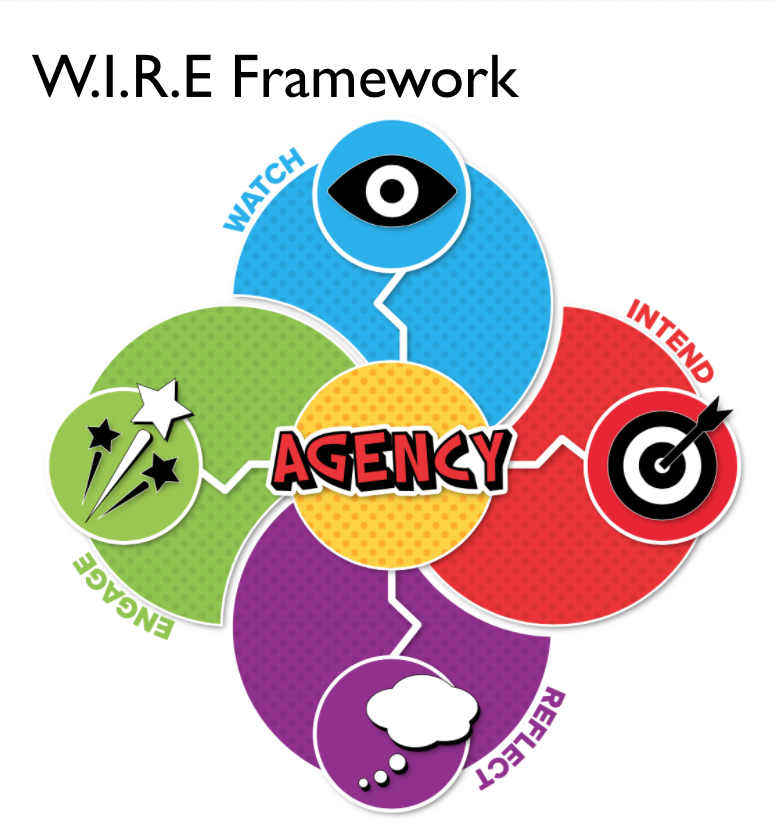Agency is becoming a popular word among teachers and administrators. It is this idea that educators discuss at great length but do not always know how to pinpoint what it is and how to put it into practice. We are hearing it more and more; yet, it still seems so elusive to so many. Teachers know what writing instruction is; they know what reading instruction looks like; most have taught math in a variety of ways. Where does agency fit in the school day? We are here to tell you, agency can take root anywhere as long as there is belief that your actions will make an impact. Learning with a sense of agency can happen at any moment in any setting. Agency is the lynchpin that brings learning and purpose together, it is belief in one’s own ability to effect a positive change for oneself:
“Wiring students for agency begins with actions we teachers take, but ends with students generating their own power as learners.”
WIRE for Agency Four Simple Moves That Transfer Learning
Agency Throughout the School Day
What:
Students Teaching Students
Where:
At the Document Camera and Small Group Table
Why:
The highest level of learning occurs when we teach each other. When students step into the role of teacher they are stretching themselves as learners. Many students learn best from other students. By providing this opportunity, we are maximizing learning for all students!
How:
Drawing is an activity that our students love! Whenever they have a free moment, the room explodes with drawing. It goes beyond just creating a picture, students are steep in different techniques that you use as you draw such as shadowning, sketching, outlining, hatching and other technical strategies. With such a strong desire to grow our drawing, it was natural for students to want to share their expertise with each other and to learn from their peers. An opportunity was right there, what we did with it made all the difference. We honored their requests and provided space for students to step into the role of teachers. They picked something they wanted to teach, signed up for a time slot, made a plan, gathered supplies and then taught their classmates.

What:
Students Organize to Solve Problems
Where:
Classroom Library
Why:
Recently some third grade students were working in Jenn’s classroom. Jenn shared that it had been difficult for students to find books they wanted to read because the classroom library was not set up as a “user friendly” space for younger children to borrow books. The students got to thinking, and suggested that they would be willing to lend a hand to solve this problem.
How:
The students quickly organized a plan. First, they laid the books on the floor and started sorting them into big categories, fiction and nonfiction. There was a lot of chatter conferring with each other, checking in to see if a book belonged here or there. Then they started sorting within these broad categories into smaller ones. They thought of clever names for the bins, names that children would be drawn to. And before anyone knew it, our time together was done. They wanted more! One boy suggested that they form a club. One where they could sign up and come and work on the library during their lunchtime. Imagine that! Sure enough children have been coming, bringing new friends, and collectively working to make the library better than when they found it. They are making this all happen on their own. What would motivate this? Whenever learners come together to build something (that matters to them) agency exists. These children believe they are making a positive impact – they are wired for agency.
What:
Sharing Book Recommendations
Where:
At the Document Camera and the Mat
Why:
Any student who is recommended to the RtI process for a literacy goal is given a reading log that is to be used both at school and at home. It is done with the intention that students will see how the many grown-ups in their lives come together to support their reading goals by signing their logs. Once a week they come to the classroom library and share about the books they borrowed, and make recommendations to each other. This is where children are learning how to exercise more control over their independent reading practices, and learn how to really talk about the books they read.
How:
Children put their books up under the document camera and show each other why this book was a good one and why they might like to read it too. Some children do a shared reading of a funny part; others talk about the author; some show how the book works and how that helps them to be able to read it. The thing that they all have in common is that they are learning how to use their voices to make an impact. They believe their recommendations are important because they are influencing what others read.
Teachers Create the Conditions for Agency
Children understand that school is a place for learning. When the learning process is demystified for them, they begin to know what that process consists of: to WATCH and learn, to have an INTENTION for learning , to REFLECT on the process, and to ENGAGE for long lasting effects. Knowing this, enables the learner to take control over this process. Asserting control over one’s own learning creates the conditions for agency to exist. I know how to learn, and I can use my learning to make an impact. Agency is living and breathing within each of the stories we shared today. Whether students are: teaching others how to draw, or fixing up the classroom library, or recommending books to each other is not really the point. The really big work was the growing self-awareness of what learning is and what could be accomplished when children believe in themselves.














































